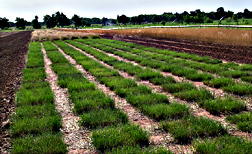This page has been archived and is being provided for reference purposes only. The page is no longer being updated, and therefore, links on the page may be invalid.
|
|
|
|
Creating the Ultimate Drought-Resistant Lawn/Pasture Grass
By Don ComisAugust 17, 2009
Bluegrass hybrids ideal for pasture and for lawns could be developed faster using genetic markers developed by an Agricultural Research Service (ARS) scientist.
ARS geneticist Jason Goldman at the agency’s Southern Plains Range Research Station in Woodward, Okla., identified nine DNA primers that produce markers that can verify successful bluegrass hybrids from DNA samples. This saves time because breeders currently have to wait for the plant to mature before they can verify a hybrid by physical characteristics. The markers can be used on seedlings.
Goldman’s goal is a Kentucky bluegrass-like lawn or pasture grass that is highly tolerant to drought. The research is part of the laboratory’s program for breeding perennial cool-season forage grasses for the southern Great Plains as alternatives to wheat and other annual crops.
Texas bluegrass is native to southern Kansas, Oklahoma, western Arkansas and most of Texas. It tolerates heat and drought, but produces seed that is difficult to harvest and re-plant. It also lacks the turf quality of Kentucky bluegrass. Kentucky bluegrass is not tolerant to heat and drought, but has excellent turf characteristics and produces seed that is easy to harvest and clean.
Goldman’s goal is to combine them into one variety with a broader geographic range than Kentucky bluegrass, while retaining Kentucky bluegrass’ good qualities. The hybrid must also retain Kentucky bluegrass’ ability to produce seed that breeds true, ensuring identical progeny.
Goldman plans further tests to cross Texas bluegrass with other bluegrass species in addition to Kentucky bluegrass, and to see if the markers can be used for other purposes, such as identifying markers linked to desirable or undesirable plant traits.
This research was published in the journal Plant Breeding.
ARS is the principal intramural scientific research agency of the U.S. Department of Agriculture.

